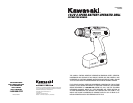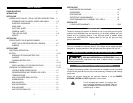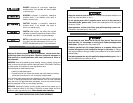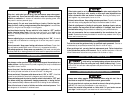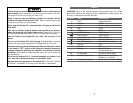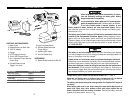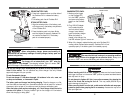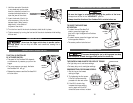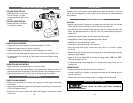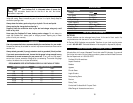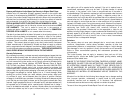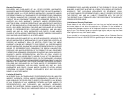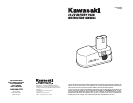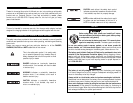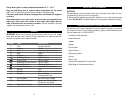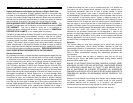
DRILLING WOOD
Use twist bits to drill holes in wood. Make sure the bits are sharp. Pull the bits
out of the hole frequently to clear chips from the flutes as an overburdened bit
may overheat.
HINTS FOR OPTIMUM USE
DRILLING:
• Keep the right amount of pressure in a straight line with the drill bit. Too little and
the bit will spin without cutting, too much and the motor may stall.
• Just before the drill tip breaks though the other side of the work piece drill more
slowly and decrease pressure on the tool. This will prevent stalling and leave a
cleaner hole.
• Use a block of wood to back up work pieces that may splinter.
• Use spade bits when drilling large diameter holes in wood.
• Use HSS drill bits when drilling in metal.
• Use masonry bits when drilling in soft masonry.
• Use a lubricant when drilling metals other than cast iron, aluminum, copper,
and brass.
• When drilling, start the hole slowly, allowing the bit to drill deep enough to prevent
slipping at higher speeds.
• Never try to start a stalled Drill by clicking the trigger switch “ON” and “OFF”.
This may damage your tool.
• To reduce jamming, always keep the Drill running when pulling the bit out of a
finished hole.
SCREWDRIVING:
• Always use the correct type and size of screwdriver bit.
• If screws are difficult to tighten, try applying a small amount of washing liquid or
soap as a lubricant.
• Always hold the tool and screwdriver bit in a straight line with the screw.
MAINTENANCE AND CLEANING
Always remove the battery pack before attempting
cleaning or maintenance.
HIGH /LOW SPEED (GEAR) SHIFTING
FOR LOW SPEED SETTING:
• Slide the switch on top of the
Drill to Position 1 for high
torque applications and driving
screws.
FOR HIGH SPEED SETTING:
• Slide the switch to Position 2
for light duty projects.
SCREWDRIVING
WHEN DRIVING FASTENERS:
• Always start slowly and gradually increase the speed of the Drill.
• Release the trigger when you feel the clutch slip.
• Always keep the driver bit straight to prevent damage to the screw.
• Hold the Drill with both hands to ensure control if the bit should stick or slip.
• To prevent wood from splitting, drill pilot holes into the wood before driving
in the screws.
DRILLING METAL
WHEN DRILLING HARD METALS:
• Apply a lubricant, such as cutting oil, to the tip of the bit.
• Start with a small hole then enlarge to the required size. Make sure the bit is
actually cutting and not spinning in the hole as this will dull the edges of the bit.
• Keep enough pressure on the bit to keep it drilling through the material.
DRILLING MASONRY
WHEN DRILLING MASONRY:
• Masonry can be brittle so be careful not to apply too much pressure and crack
the material.
• Apply enough pressure to keep the bit cutting and not spinning in the hole as this
will dull the edges of the bit.
• Bricks and similar soft materials will require less pressure, concrete will require
much more.
15 16
HIGH SPEEDLOW SPEED



